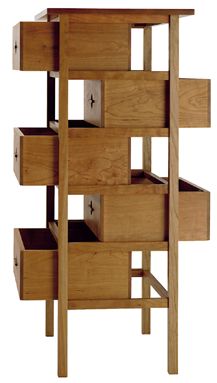 |


|
 |
The
Joinery
 |
Joinery
is as much a part of all M.T. Maxwell furniture pieces as is the
primary structural element, superbly and subtly figured cherry.
For the ultimate in strength, mortises and mitered tenons are
used in frame corners. The frames, forming external skeletons,
are themselves a design element. The external frames let the drawer
sides become the sides of the pieces. Open frames simplify the
lines and keep a crisp, clean look which perfectly complements
the warmth of the cherry. |
 |
The Drawers
 |
All
drawers use lap joints, pegged with walnut dowels for strength
and color contrast with the much lighter-toned cherry. The overall
look is quietly dramatic, made more so by the bored-through pull
holes on the drawers, with walnut cross bars. The trestle dining
room tables use through tenons in the lower rail, with walnut
keys to make them easily taken down, but extremely solid when
assembled. |
 |
The Drawer Slides
 |
Drawer
slides are all wood, with walnut slides gliding in cherry drawer
sides. Such wood-on-wood slide design was once common, extending
well beyond the Colonial era and even into this century, but fell
into disuse with the ease of installation of less expensive metal
guides. The only metal used in most M.T. Maxwell furniture is
found in the bed frames (for the connectors that hold the side
rails in place), hinges, and small screws that hold the drawer
stops in place. |
 |
The
Historic Features
 |
Michael
Maxwell has brought historic features into a contemporary setting,
using the wood itself as the primary design element, and holding
other features to a minimum. Another integral design element of
our furniture is the use of octagonal spindles. Pegged at each
end with walnut, the piece is more attractive for this feature,
and also sturdier. |
 |
The Finish
 |
M.T.
Maxwell hand-rubs three coats of polymerized tungoil, a clear
finish that brings out the beauty of the unstained wood, while
providing exceptional protection. To top things off, a wax is
hand-rubbed into the finish for added luster. |
 |
|



